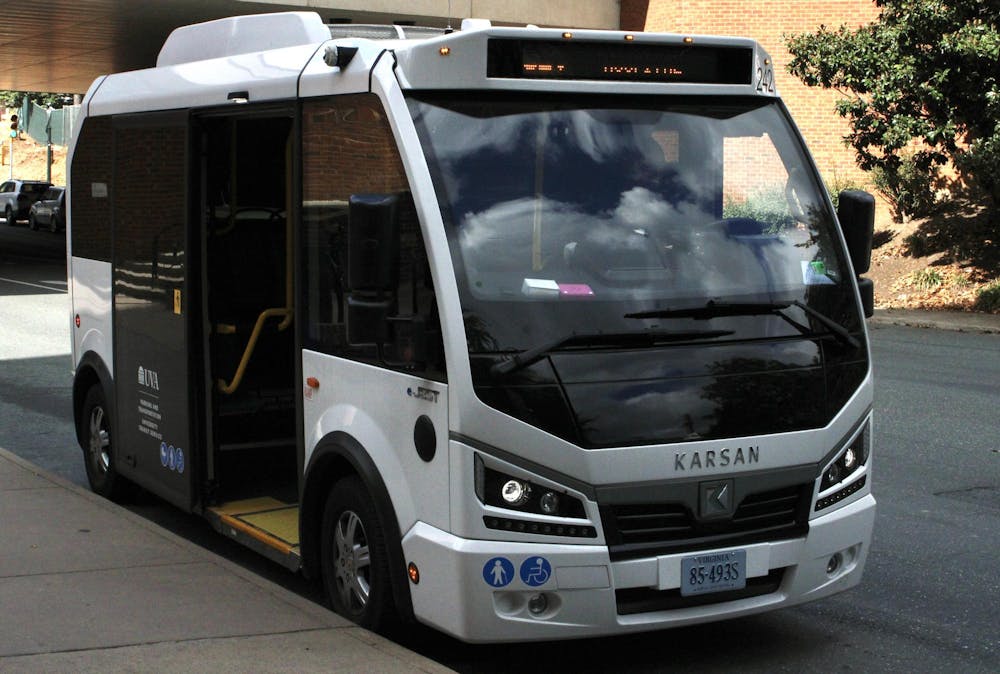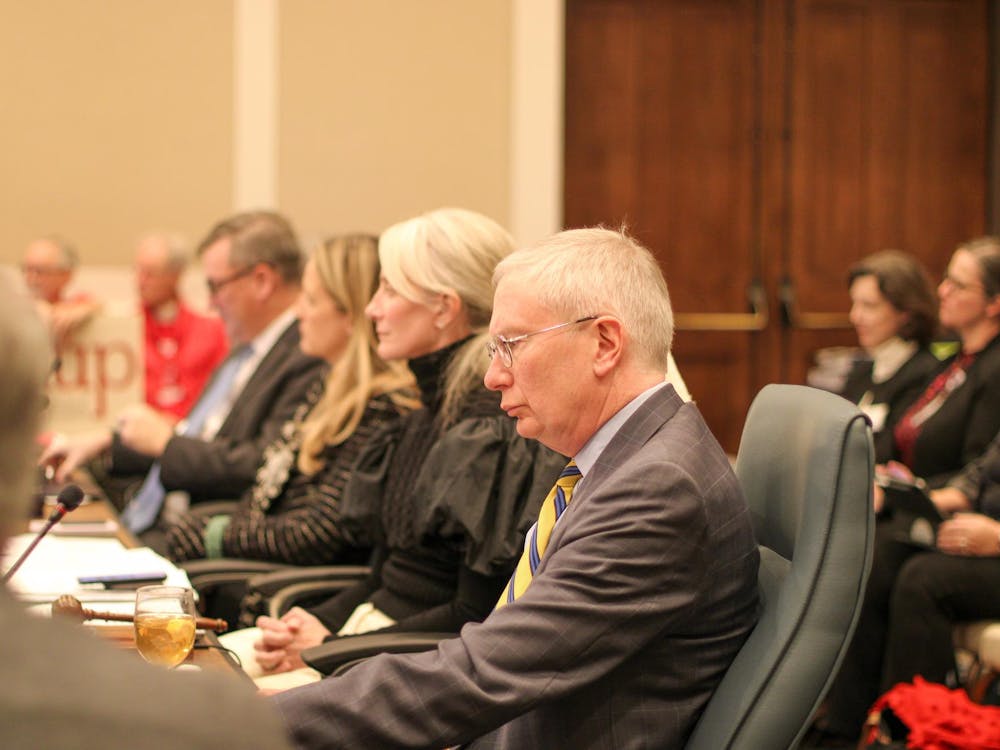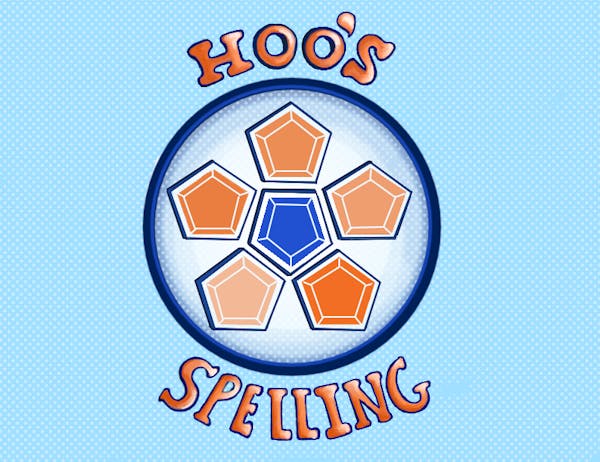The University Transit Service added new electric minibuses — known as e-Jest — to its fleet in April, replacing larger Gillig diesel buses on the Silver Line. These new vehicles reflect a push towards a more sustainable, cost-effective and adaptable transportation option for students to get around Grounds.
The e-Jest buses, built by Turkish manufacturer Karsan, are smaller than traditional UTS buses, holding up to 19 passengers. According to Ian Travis, chair of Student Council’s Community Concerns Committee and third-year College student, e-Jest buses have a range of about 100 miles per charge and are fully electric.
Originally, UTS relied on Gillig diesel full-sized models to carry large passenger loads, seating more than 30 passengers. Moving forward, UTS services are gradually shifting toward smaller, electric e-Jest vehicles with hopes to add more minibuses to different routes.
The e-Jest buses were initially showcased to the University at an event in April, and then began running in the spring on the Fontaine shuttle route, according to Travis. This route primarily connects commuter parking lots at Fontaine Research Park to central Grounds. After several months, these vehicles were reassigned to the Silver Line instead of the Fontaine shuttle route, just before the start of the fall semester.
The Silver Line runs down Jefferson Park Avenue through the University School of Medicine and down University Avenue past the Corner. The line continues down Emmet Street towards the School of Data Science and John Paul Jones Arena.
The compact size of e-Jest buses allows them to operate on narrow roads and under lower bridges that larger buses are unable to navigate. Travis said that this makes the e-Jest buses a versatile addition to the UTS.
“They’re finally able to go down Wertland Street … [and] under the 14th Street Bridge,” Travis said. “For the first time, U.Va. has a minibus that’s not like a van, so it’s a good compromise.”
This switch to minibuses allowed UTS to adjust the Silver Line’s frequency. Previously, the route ran every 30 minutes using a full-sized Gillig diesel bus. With these smaller e-Jest vehicles, UTS now runs two buses every 15 minutes to meet student demand.
“The capacity in the e-Jest is so much smaller … They couldn’t justify having two Gillig [buses] running around [for] 30 minutes service, but you can now have two e-Jest running around,” Travis said. “That’s a justifiable frequency for the amount of passengers because they’re a lot smaller and they cost a lot less to run.”
Currently, the buses operate exclusively on the Silver Line and as game-day shuttles. As UTS expands its fleet, Travis expects them to assign the e-Jest buses to additional routes.
For students who rely on UTS daily, the transition to smaller buses has been noticeable. Second-year College student Emma McGowan lives in Gaston House, and said she uses the e-Jest buses four to five times per week to reach her classes and visit friends near Lambeth Field Apartments, located closer to central Grounds.
“It stopped at the stop close to my apartment, and I was waiting for it one time to go to the dining hall and a little white bus came out of nowhere,” McGowan said. “I was like, ‘What is this?’ Then I realized it was the Silver Line here at U.Va.”
McGowan finds the e-Jest buses more reliable than scooters and just as convenient as other fare-free UTS services, such as the Night Pilot and UTS OnDemand. However, she expressed concern regarding their size compared to the Gillig buses and whether the seating capacity will be able to meet the demand. Although the e-Jest buses are smaller, McGowan said these new electric buses are an important addition to the University’s transit system.
“They’re definitely important as they make up one of the core lines of the U.Va. buses, and I’ve seen plenty of people use them,” McGowan said.
As a frequent passenger of the e-Jest buses, second-year College student Fernando Zamora Mata first used the e-Jest buses on the Silver Line during the first week of this fall semester. He said that while the smaller size can feel tight when the bus is full, he appreciates the University’s move toward electric transportation.
“The step towards a fully electric bus definitely reflects the needs of students and society as a whole,” Zamora Mata said. “An improvement that could be made — just have them more frequently. But in terms of the actual vehicle itself, I think it is a step up from the traditional buses if that increased frequency is achieved.”
Zamora Mata added that he finds the e-Jest buses more convenient than other transit options, especially given their accessibility. He believes that if UTS expands these e-Jest buses across all routes, they could significantly improve how students use transportation around Grounds.
“If every line had the tiny buses alongside the big buses … [sending] the big ones when there’s higher demand … and the tiny ones when there’s lower demand. This could be an efficient way to run the bus network,” Zamora Mata said. “It could shape the [student] experience if it was more optimized.”
In addition to its sustainability, e-Jest buses are equipped with passenger counters that provide more accurate ridership data and possess accessibility features such as a wheelchair platform. For Travis, who became interested in transportation issues as a first-year student on Student Council’s Student Life Committee, the introduction of the e-Jest buses represents an important step toward modernizing UTS.
“They’re easy to operate, and being European, it makes me happy to see them because … they’re efficient on our tiny roads in Charlottesville,” Travis said. “They are a great step for the future of UTS, and they will serve us well for the future.”







